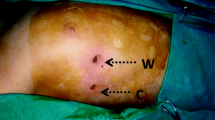Abstract
Objectives
Thoracic sympathectomy is considered the most effective method to treat palmar hyperhidrosis. We presented a novel procedure for thoracic sympathectomy treating palmar hyperhidrosis which could be performed under monitored anesthesia care. The aim of this study was to evaluate the continuing efficacy and safety of this innovative surgery.
Method
From May 2011 to May 2014, we performed the single-port endoscopic thoracic sympathectomy (ETS) with a flexible thoracoscopy in 32 patients under monitored anesthesia care. All patients were followed up until today.
Results
Under monitored anesthesia, all patients were awake during the procedure. A proper sedation and local anesthesia make it possible for patients to communicate with surgeons. The symptoms disappeared immediately when the sympathectomy was done. No surgical complications occurred during the procedure. All patients were discharged from the hospital on the first morning of postoperative day. Compared with the traditional approach, the advantages of less operative costs, fewer hospital days, and better recovery were suggested.
Conclusions
Single-port ETS with flexible thoracoscopy under monitored anesthesia is a promising procedure for palmar hyperhidrosis.

Similar content being viewed by others
References
Shargall Y, Spratt E, Zeldin RA (2008) Hyperhidrosis: what is it and why does it occur? Thorac Surg Clin 18:125–132
Allen GM (2001) Thoracoscopic sympathectomy for palmar hyperhidrosis. AORN J 74:178–182
Tu YR, Li X, Lin M, Lai FC, Li YP, Chen JF et al (2007) Epidemiological survey of primary palmar hyperhidrosis in adolescent in Fuzhou of People’s Republic of China. Eur J Cardiothorac Surg 31:737–739
Kux MT (1978) Thoracic endoscopic sympathectomy in palmar and axillary hyperhidrosis. Arch Surg 113:264–266
Assalia A, Kopelman D, Markovits R, Hashmonai M (2003) Intrapleural analgesia following thoracoscopic sympathectomy for palmar hyperhidrosis: a prospective, randomized trial. Surg Endosc 17:921–922
De Campos JRM, Kauffman P, Werebe ED, Andrade LO, Kusniek S, Wolosker N et al (2003) Quality of life, before and after thoracic sympathectomy: report on 378 operated patients. Ann Thorac Surg 76:886–891
Ng CS, Yeung EC, Wong RH, Kwok MW (2012) Single-port sympathectomy for palmar hyperhidrosis with Vasoview Hemopro 2 endoscopic vein harvesting device. J Thorac Cardiovasc Surg 44:1256–1257
Miller DL, Bryant AS, Force SD, Miller JI Jr (2009) Effect of sympathectomy level on the incidence of compensatory hyperhidrosis after sympathectomy for palmar hyperhidrosis. J Thorac Cardiovasc Surg 138:581–585
Wait SD, Killory BD, Lekovic GP, Dickman CA (2010) Biportal thoracoscopic sympathectomy for palmar hyperhidrosis in adolescents. J Neurosurg Pediatr 6:183–187
Inan K, Goksel OS, Uçak A, Temizkan V, Karaca K, Ugur M et al (2008) Thoracic endoscopic surgery for hyperhidrosis: comparison of different techniques. Thorac Cardiovasc Surg 56:210–213
Reisfeld R, Nguyen R, Pnini A (2002) Endoscopic thoracic sympathectomy for hyperhidrosis: experience with both cauterization and clamping methods. Surg Laparosc Endosc Percutan Tech 12:255–267
Agostoni M, Fanti L, Gemma M, Pasculli N, Beretta L, Testoni PA (2011) Adverse events during monitored anesthesia care for GI endoscopy: an 8-year experience. Gastrointest Endosc 74:266–275
Cote GA, Hovis RM, Ansstas MA et al (2010) Incidence of sedation-related complications with propofol use during advanced endoscopic procedures. Clin Gastroenterol Hepatol 8:137–142
Berzin TM, Sanaka S, Barnett SR et al (2011) A prospective assessment of sedation-related adverse events and patient and endoscopist satisfaction in ERCP with anesthesiologist-administered sedation. Gastrointest Endosc 73:710–717
Amornyotin S, Kachintorn U, Kongphlay S (2012) Anesthetic management for small bowel enteroscopy in a World Gastroenterology Organization Endoscopy Training Center. World J Gastrointest Endosc 4:189–193
Alzahrani M, Martin F, Lescanne E (2014) Combined local anesthesia and monitored anesthesia care for cochlear implantation. Eur Ann Otorhinolaryngol Head Neck Dis 131(4):261–262
Busick T, Kussman M, Scheidt T et al (2008) Preliminary experience with dexmede to midine for monitored anesthesia care during ENT surgical procedures. Am J Ther 15(6):520–527
Berkenstadt H, Perel A, Hadani M, Unofrievich I, Ram Z (2001) Monitored anesthesia care using remifentanil and propofol for awake craniotomy. J Neurosurg Anesthesiol 13(3):246–249
Tschopp JM, Purek L, Frey JG, Schnyder JM, Diaper J, Cartier V et al (2011) Titrated sedation with propofol for medical thoracoscopy: a feasibility and safety study. Respiration 82:451–457
Fritscher-Ravens A, Patel K, Ghanbari A et al (2007) Natural orifice transluminal endoscopic surgery (NOTES) in the mediastinum: long-term survival animal experiments in transesophageal access, including minor surgical procedures. Endoscopy 39:870–875
Kobayashi T, Lemoine S, Sugawara A et al (2005) A flexible endoscopic surgical system: first report on a conceptual design of the system validated by experiments. Jpn J Clin Oncol 35:667–671
Canes D, Lehman AC, Farritor SM et al (2009) The future of NOTES instrumentation: flexible robotics and in vivo minirobots. J Endourol 23:787–792
Zhu LH, Du Q, Chen L, Yang S, Tu Y, Chen S, Chen W (2014) One-year follow-up period after transumbilical thoracic sympathectomy for hyperhidrosis: outcomes and consequences. J Thorac Cardiovasc Surg 147(1):25–28
Acknowledgments
This clinical study was supported by grants from National Natural Science Foundation of China (Grant Number: 81101833) and Shanghai Outstanding Young Physician Foundation (Grant Number 20120149).
Author information
Authors and Affiliations
Corresponding authors
Additional information
Ye Ning and Yanan Wang have contributed equally to this work.
Electronic supplementary material
Below is the link to the electronic supplementary material.
Rights and permissions
About this article
Cite this article
Ning, Y., Wang, Y., Tao, X. et al. Single-Port Endoscopic Thoracic Sympathectomy with Monitored Anesthesia Care: A More Promising Procedure for Palmar Hyperhidrosis. World J Surg 39, 2269–2273 (2015). https://doi.org/10.1007/s00268-015-3104-7
Published:
Issue Date:
DOI: https://doi.org/10.1007/s00268-015-3104-7




